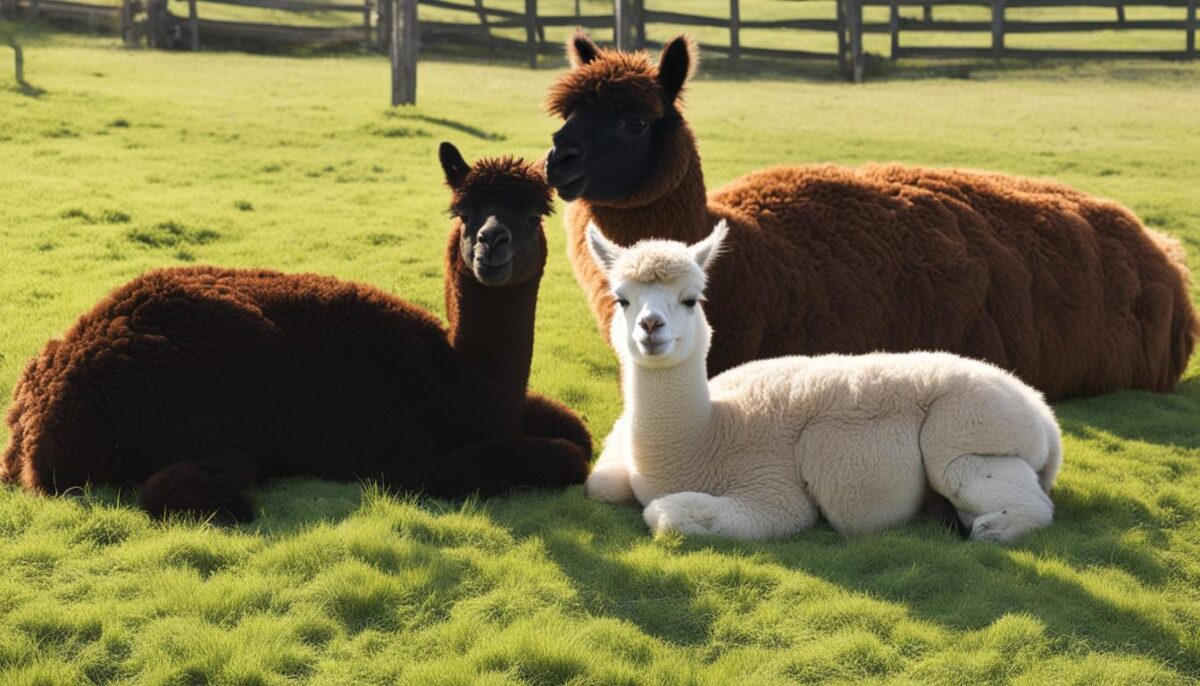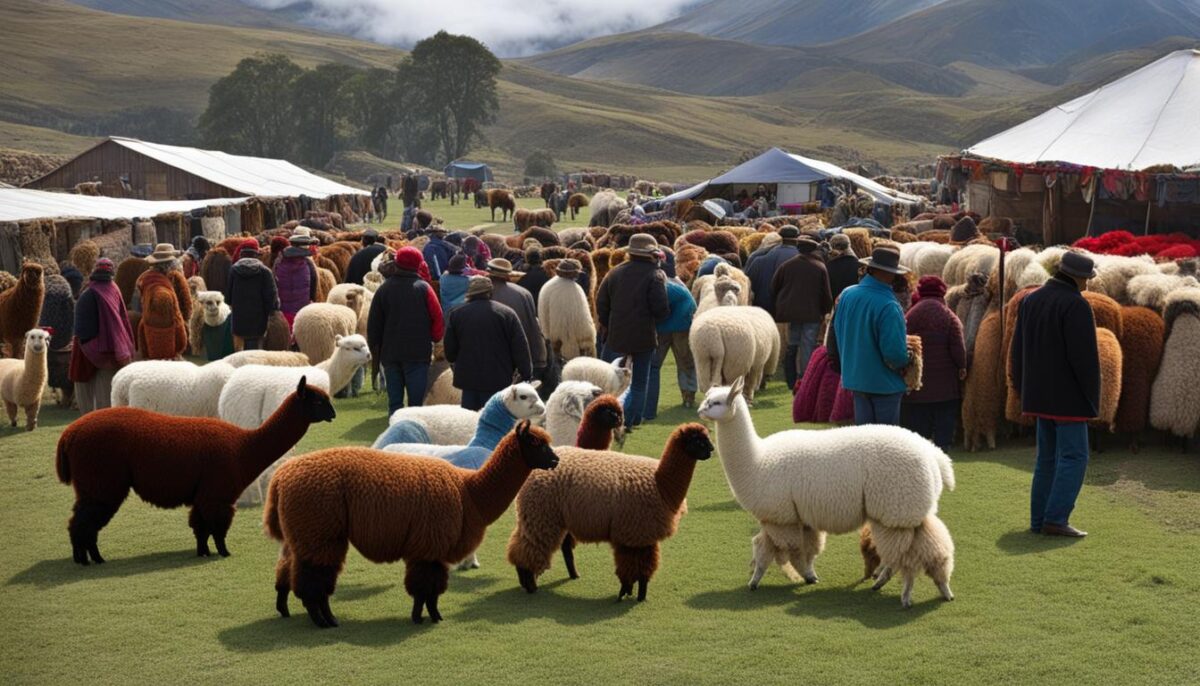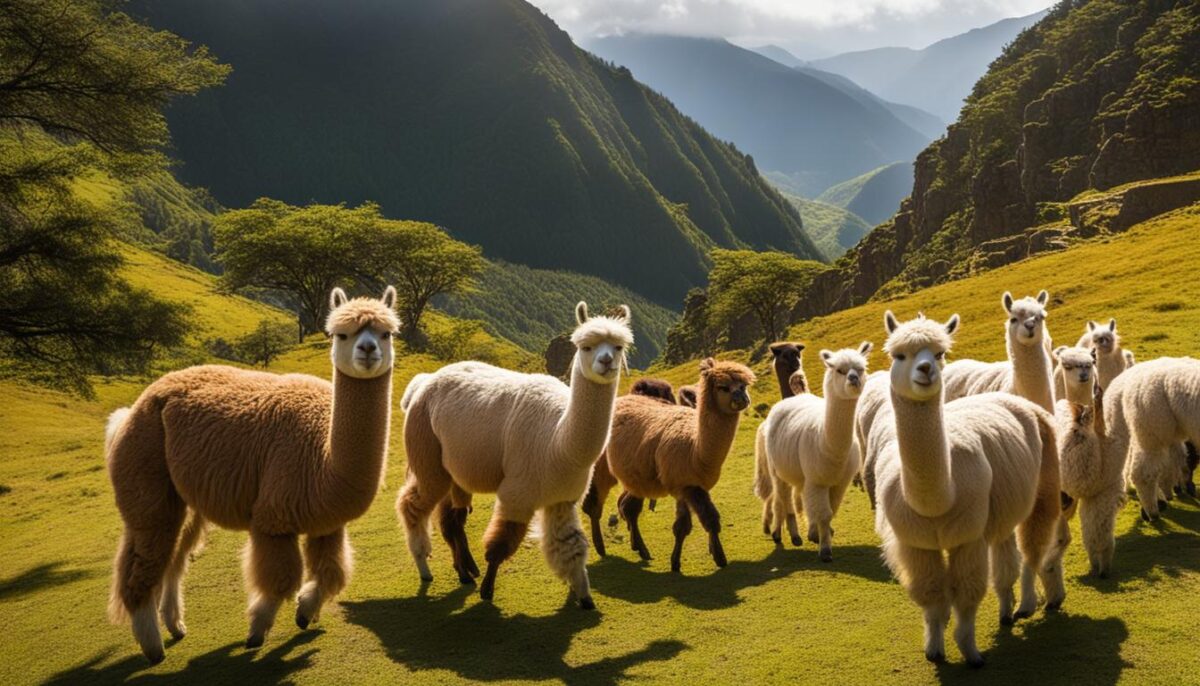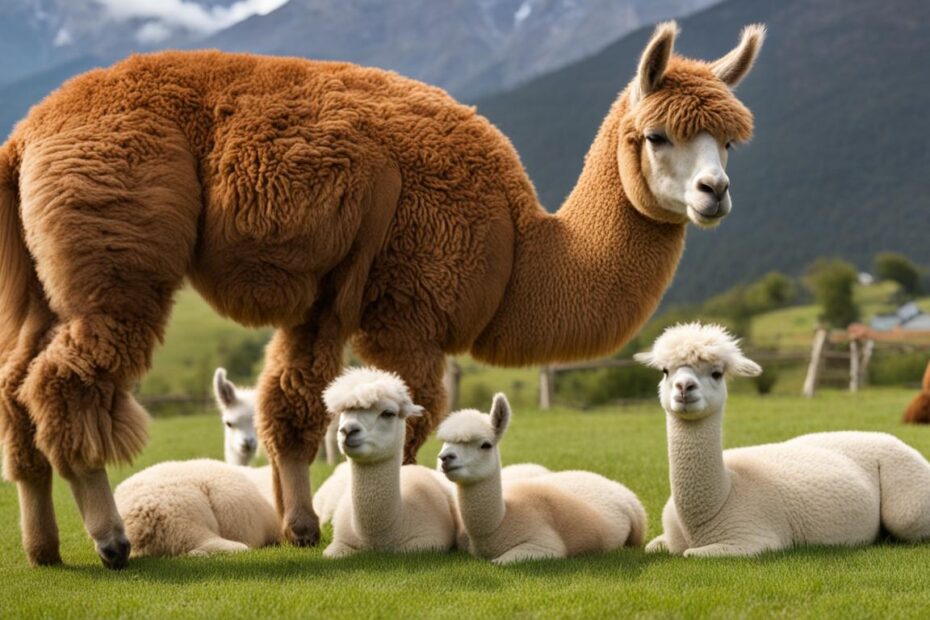Are you curious about the reproductive cycle of alpacas and how many babies they have in one go? Let’s dive into the fascinating world of alpaca reproduction.
Alpacas have a unique reproductive cycle that involves a gestation period and specific breeding seasons. Understanding their reproductive patterns is essential for alpaca farmers and enthusiasts alike.
Key Takeaways:
- Alpacas have a gestation period of 11 to 11.5 months.
- Females typically give birth to a single cria.
- Twin births are extremely rare, occurring in only one set out of every 10,000 births.
- Alpacas are polyestrous, meaning ovulation can occur unexpectedly about 26 hours after mating.
- They are induced ovulators, able to mate at any time of the year.
Alpaca Breeding Season and Reproductive Lifespan
The alpaca breeding season typically occurs from the end of November to late April or early May. During this time, males and females engage in mating behavior to reproduce. Female alpacas reach full maturity between 10 to 18 months of age, while males need to be approximately 2.5 to 3 years old before they can successfully reproduce.
A female alpaca has a reproductive lifespan of approximately 1.5 to 19 years, during which they can give birth to crias. Meanwhile, a male alpaca has a reproductive lifespan of approximately 2.0 to 18 years, during which they can sire offspring.
It is important for alpaca breeders to carefully manage the breeding season, ensuring that males and females are introduced at the appropriate time to increase the chances of successful reproduction. By understanding the alpaca’s breeding season and reproductive lifespan, breeders can effectively plan and manage their alpaca breeding programs.
Reproductive Lifespan of Female and Male Alpacas
| Alpaca | Reproductive Lifespan |
|---|---|
| Female Alpaca | Approximately 1.5 to 19 years |
| Male Alpaca | Approximately 2.0 to 18 years |
Table: Reproductive Lifespan of Female and Male Alpacas
Understanding the reproductive lifespan of female and male alpacas is crucial for breeders. Female alpacas have a range of fertile years, during which they can conceive and give birth to crias. Male alpacas, on the other hand, have a similar reproductive lifespan but can sire offspring. By carefully managing the breeding season and considering the reproductive lifespan, breeders can maximize the reproductive potential of their alpaca herds.
Alpaca Birth Rate and Weaning Age
Understanding the birth rate and weaning age of alpacas is crucial for alpaca breeders and enthusiasts. Alpacas have a relatively low birth rate, with females typically producing one cria per year. This slow reproduction rate is due to their long gestation period of 11 to 11.5 months. Unlike other animals that may have multiple offspring at once, alpacas usually give birth to a single cria, weighing around 6 to 8kg (13 – 18 lbs) at birth. However, twin births in alpacas are extremely rare, occurring in only one set out of every 10,000 births.
Once alpacas are born, they go through a rapid development process. Alpaca crias are usually able to stand and feed on their own shortly after birth. This quick adaptation is vital for their survival in the wild and on farms. Alpacas crias are weaned between 5 and 6 months of age, at which point they can be separated from their mothers. This allows the mother to recover and prepare for another potential pregnancy, while the cria begins to explore and grow independently.
Key Points:
- Alpacas have a low birth rate, usually producing one cria per year.
- Twin births in alpacas are extremely rare, occurring in only one set out of every 10,000 births.
- Alpaca crias weigh around 6 to 8kg (13 – 18 lbs) at birth.
- Crias are typically weaned between 5 and 6 months of age.
- Alpaca crias have a rapid development process and can stand and feed shortly after birth.
Understanding the birth rate and weaning age of alpacas is essential for managing their breeding and overall well-being. Breeders can use this knowledge to plan for the arrival of new crias and ensure their proper care and growth. By maintaining a steady birth rate and monitoring the weaning process, alpaca breeders can contribute to the healthy development of their alpaca populations.
Alpacas Gestation Period and Birth Time
Understanding the gestation period and birth time of alpacas is crucial for successful breeding and herd management. Alpacas have a gestation period of 11 to 11.5 months, which is significantly longer than many other domesticated animals. This extended period allows for the proper development and growth of the cria (baby alpaca) inside the mother’s womb. As a result, alpacas typically give birth to healthy and strong crias.
During the breeding season, female alpacas can mate multiple times, but only one mating is usually enough to achieve pregnancy. After mating, the female alpaca’s reproductive cycle starts, and she will carry the cria for the full gestation period. It is important to note that alpacas are induced ovulators, meaning ovulation occurs unexpectedly about 26 hours after mating. This unique reproductive characteristic of alpacas allows for year-round breeding, as they can mate at any time of the year.
Alpaca crias are typically born during daylight hours, usually between 7 am to 2 pm. This ensures that they have enough time to dry and adjust to their new surroundings before nightfall. It is important to provide shelter and monitoring during the birthing process to ensure the safety and well-being of both the mother and cria. With proper care and attention, alpacas can continue to contribute to their herd’s growth and genetic diversity.

| Stage | Timeline |
|---|---|
| Mating | Year-round |
| Gestation Period | 11 to 11.5 months |
| Birth Time | 7 am to 2 pm |
Alpacas Reproduction Facts and Lifespan
Alpacas, like other members of the South American camelid family, have a unique reproductive cycle. Understanding the facts about alpaca reproduction is essential for those involved in breeding and raising these majestic animals. Alpacas have a lifespan of 18 to 24 years, with some wethers living up to 26 years, making them long-term companions for their owners.
Female alpacas, known as Hembras, spend a significant portion of their lives pregnant. They are typically bred every year, ensuring a consistent alpaca population. Male alpacas, or Machos, play an important role in reproduction, mating with the females to facilitate conception. Alpacas are social animals, and their reproductive cycle helps maintain healthy and abundant herds.
It’s worth noting that alpacas have different names based on their age and gender. Yearlings are called Tuis, and babies are referred to as Crias. This naming convention adds to the uniqueness and charm of these creatures. Alpacas are gentle and inquisitive, making them delightful companions for farmers and enthusiasts alike.
Alpacas Lifespan
The lifespan of an alpaca is influenced by various factors, such as nutrition, healthcare, and breeding practices. On average, alpacas live for 18 to 24 years. However, some wethers have been known to live up to 26 years, showcasing the longevity of these remarkable animals. Alpacas are known for their hardiness, adaptability, and ability to thrive in various climates, contributing to their overall well-being and extended lifespan.
As alpaca owners and breeders, it is important to provide these animals with proper nutrition, regular veterinary care, and a safe environment. By doing so, we can ensure that they live long and healthy lives, bringing joy and companionship to those who appreciate their unique qualities.
Alpacas Reproduction and the Alpaca Fiber Market
Alpacas are fascinating animals not only for their reproductive cycle but also for their valuable fleece. The alpaca fiber market has seen a significant rise in demand, driven by Italian, Chinese, and Japanese fashion houses. These fashion powerhouses recognize the unique qualities of alpaca fiber, such as its softness, warmth, and hypoallergenic properties. As a result, the UK and European alpaca industries are focused on breeding alpacas for their high-quality fleece, aiming to meet the global demand.
The process of alpaca breeding for fleece involves carefully selecting breeding pairs based on their fiber characteristics. Breeders strive to improve the quality of the fleece by considering factors such as fineness, staple length, crimp, and color. By selectively breeding for these traits, breeders can produce alpacas with superior fiber quality, meeting the standards of the international market.
To understand the significance of alpaca breeding for fleece, let’s take a look at the following table:
| Characteristics | Benefits |
|---|---|
| Softness | Provides a luxurious feel and enhances comfort |
| Warmth | Offers excellent insulation, keeping the wearer cozy in cold weather |
| Hypoallergenic | Does not cause allergic reactions, making it suitable for sensitive skin |
| Fineness | Ensures a smooth, delicate texture for garments |
| Staple length | Allows for strong and durable yarn production |
| Crimp | Provides elasticity and bounce to the fiber |
| Color | Offers a wide range of natural shades, reducing the need for dyeing |
As the alpaca fiber market continues to thrive, breeders play a crucial role in ensuring the availability of high-quality fleece. Their efforts in selective breeding contribute not only to the profitability of the industry but also to the preservation and appreciation of alpacas as a valuable resource.

Alpacas as Livestock and Flock Protectors
Alpacas are not only valuable for their fleece and breeding capabilities but also for their role as livestock and flock protectors. Their gentle nature and natural defense mechanism make them effective guardians against predators such as dogs and foxes, particularly when it comes to protecting sheep and chickens.
Australian sheep farmers have successfully used alpaca wethers (geldings) as guard animals for their flocks. Alpacas have a strong instinct to protect, and their presence alone can help deter potential threats. They will often alarm call, stomp their feet, and even spit if they feel threatened.
When it comes to raising alpacas alongside other livestock, such as sheep, horses, or cows, they can coexist harmoniously. Alpacas have a calming effect on other animals and can help reduce stress within the herd. They are known to establish bonds with their fellow pasture mates, fostering a sense of security and companionship.
“Alpacas have a strong instinct to protect, and their presence alone can help deter potential threats.”
| Alpacas as Livestock and Flock Protectors | Benefits |
|---|---|
| 1. Effective predator deterrent | Alpacas can deter predators such as dogs and foxes, providing an added layer of protection for sheep and chickens. |
| 2. Calming effect on other animals | The presence of alpacas can help reduce stress among other livestock, fostering a sense of security and companionship. |
| 3. Natural defense mechanism | Alpacas have a natural instinct to protect and will alarm call, stomp their feet, and even spit if they feel threatened. |
Overall, alpacas serve as valuable livestock and flock protectors, adding an extra layer of security to the farm. Their calm demeanor and natural instincts make them an asset in safeguarding other animals and deterring potential predators.
Alpacas and Traveling
When it comes to traveling, alpacas are known for their remarkable adaptability and ease of transportation. Whether you need to move them to a new location or take them for a short journey, alpacas are surprisingly good travelers.
Transporting alpacas is relatively straightforward. They can be transported in a horsebox or stock trailer, just like other livestock animals. Once they are on the move, alpacas usually sit down and enjoy the journey, making it a hassle-free experience for both the alpacas and their caregivers.
One of the reasons alpacas are such good travelers is their ability to adapt to new environments. Whether they are traveling alone or alongside other animals, such as horses or dogs, alpacas can settle into their new surroundings quite well. This makes it easier for alpaca owners to take their animals to shows, events, or even on vacation without worrying about their well-being.
Alpacas as Travelers – Key Points:
- Alpacas can be transported in a horsebox or stock trailer.
- They usually sit down and enjoy the journey.
- Alpacas are adaptable to new environments.

Table: Alpaca Transportation Tips
| Transportation Method | Tips |
|---|---|
| Horsebox or Stock Trailer |
|
| Safety Precautions |
|
| Adapting to New Environment |
|
Traveling with alpacas is not only practical but also rewarding. Their calm nature and adaptability make them ideal companions for journeys and adventures.
Alpacas vs. Llamas and Land Requirements
When comparing alpacas and llamas, it’s important to note that both are members of the South American camelid family. However, there are some key differences between these two animals.
Firstly, alpacas are generally smaller in size compared to llamas. An average alpaca weighs between 60 to 80 kilograms (132 to 176 pounds), while llamas can weigh anywhere from 150 to 210 kilograms (330 to 462 pounds). This size difference is reflected in their physical appearance, as llamas have a more robust build compared to the slender frame of alpacas.
In addition to size, alpacas and llamas also differ in terms of their fleece. Alpacas produce a more advanced and sought-after fleece type, known for its softness, warmth, and luxurious feel. On the other hand, llamas have coarser fleece, which is often used in the production of rugs and ropes.
| Category | Alpacas | Llamas |
|---|---|---|
| Size (average weight) | 60 to 80kg (132 to 176 lbs) | 150 to 210kg (330 to 462 lbs) |
| Fleece Type | Advanced and sought-after | Coarser |
When it comes to land requirements, alpacas typically require about 1 acre of land per 6 alpacas. This allows them enough space to graze and move around comfortably. However, with proper land rotation and improved pasture, higher stocking rates can be achieved while maintaining the health and well-being of the alpacas.
Overall, while alpacas and llamas share similarities as South American camelids, they have distinct differences in terms of size, fleece type, and land requirements. Understanding these differences is essential for anyone considering raising these unique animals.
Conclusion
In conclusion, alpacas have a unique reproductive cycle that contributes to their population growth. With a gestation period of 11 to 11.5 months, female alpacas typically give birth to one cria per year. It is important to note that twin births are extremely rare, occurring in only one set out of every 10,000 births.
Alpacas are social animals and can be raised alongside other livestock. They are often used as guardians, particularly for sheep and chickens, due to their ability to deter predators. Alpacas have a lifespan of 18 to 24 years and are not only farmed for their luxurious fleece but also for their pedigree bloodstock.
The alpaca breeding cycle plays a crucial role in maintaining healthy alpaca populations. Female alpacas reach full maturity between 10 to 18 months of age, while males need to be approximately 2.5 to 3 years old before they can reproduce. The alpaca breeding season typically falls between the end of November to late April or early May.
Overall, alpacas are fascinating creatures that offer both economic and protective benefits. Their reproductive cycle, low birth rate, and lifespan contribute to the sustainability of alpaca farming and the satisfaction of the global demand for their fleece.
FAQ
How long is the gestation period for alpacas?
The gestation period for alpacas is 11 to 11.5 months.
How many babies do alpacas typically have in one go?
Alpacas usually give birth to a single cria, although twin births are very rare.
When is the alpaca breeding season?
The typical alpaca breeding season is from the end of November to late April or early May.
At what age do female alpacas reach full maturity?
Female alpacas reach full maturity between 10 to 18 months of age.
How old do male alpacas need to be before they can reproduce?
Male alpacas need to be approximately 2.5 to 3 years old before they can reproduce.
How many crias do female alpacas produce per year?
Female alpacas typically produce one cria per year.
How much does an alpaca cria weigh at birth?
The average alpaca cria weighs 6 to 8kg (13 – 18 lbs) at birth.
Are twin births common in alpacas?
No, twin births in alpacas are very rare, occurring in only one set out of every 10,000 births.
How long do alpaca crias stay with their mothers?
Alpaca crias are weaned between 5 and 6 months of age.
What is the lifespan of an alpaca?
Alpacas have a lifespan of 18 to 24 years, with some wethers (neutered males) living up to 26 years.
How are alpacas used in the fashion industry?
Alpacas are farmed for their fleece, which is in high demand by Italian, Chinese, and Japanese fashion houses.
Can alpacas be raised alongside other livestock?
Yes, alpacas can be raised alongside other common livestock animals such as sheep, horses, and cows.
Can alpacas be used as flock protectors?
Yes, alpacas are effective at deterring predators like dogs and foxes, making them excellent guardians for sheep and chickens.
How do alpacas behave during transportation?
Alpacas are known for being good travelers and can be transported in a horsebox or stock trailer. They usually sit down and enjoy the journey once they are on the move.
What are the differences between alpacas and llamas?
Alpacas are smaller in size and have a more advanced fleece type compared to llamas. Alpacas typically weigh 60 to 80kg, while llamas weigh 150 to 210kg.
How much land do alpacas require?
Alpacas require about 1 acre of land per 6 alpacas, with higher stocking rates possible with land rotation and improved pasture.


